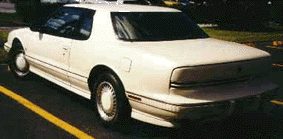

I found this under the GM news group (alt.autos.gm) and thought it might be interesting to those of us who drive the 3800 Toronados.
Jon
******************************************************************************
As the Service Administrator at a Buick dealer, it's nice to see all these good quotes about the 3800. It IS a very good, solid, reliable engine. It does have its minor faults, like all mechanical items. The 3800 is ranked as one of the 10 most reliable engines in the world by Ward's Automotive.
The 3800 is the latest name for the 231 Buick V-6 that has been around in that displacement since the mid 70's, and actually was designed in the late 50's/early 60's (don't remember exactly) Buick sold the design, dies and stamping assemblies to the Rover Group (England) in the 60's when the muscle car wars started, then GM went scrambling to buy it back in the early 70's when the gas crisis hit.
The "A" motor (it's VIN designation) and its relatives does have an oil pump problem, as alluded to by one poster. This engine was used up until 87 in the Regal, and in many other models as far back as 76. It also has a tendancy to chew up timing chains a bit earlier than expected. The first generation front wheel drive "B" motor was just the 231 turned sideways (FWD) with a rudimentary port fuel injection system. It was only used from 84-85 in a handful of Centurys with the Sport package and the first FWD Electra/Park Avenues. It still had a distributor. This engine had a number ofproblems, including the 231's habit of chewing up chains and the oil pump problem. The "3" motor used from 85-87 in the Century, Park Avenue, Lesabre, and Riviera. It had the first stage redesigned Gerotor oil pump, which used a gear in a gear design, eliminating the oil pump problem. This engine still had problems with timing chains, and also developed the habit of wearing out water pumps and alternators. Next came the "C" motor, used from 88-91 in Park Avenues, Lesabres, Rivieras and Reattas. They still have timing chain problems, although not as bad. The water pump and alternator problem got worse, but the oil pump problem was solved. They have a slight tendancy at higher miles to wear out valve stem seals and seats, but not really any worse than most other high mile engines. The "L" motor comes next, and this one was used from 91-95 in damn near everything Buick (and GM) makes. The Lesabre, Park Avenue, Regal, Riviera, Reatta (and Olds 88, Olds 98, Camaro, Transport, and Bonneville) used this one. This engine has almost eliminated the timing chain problem. However, the water pumps on these average about 50-60,000 miles, and the alternators get noisy to soon, and then eventually start to drop out put. This engine has the balance shaft as well, so it is a very smooth running engine, and also very clean from an emissions standpoint. Last, we come to the current "K" motor. This one has elimnated the water pump problem (redesigned the belt routing to put less load on the pump), mostly fixed the alternator problem (GM finally put a decent sized alternator on the damn thing and moved it to a cooler location in the engine bay) and has developed early signs of breaking valve stem seals. We've seen a few with valve guide problems, but not many have been severe. In addition, there is the "1" (one) motor. This is the supercharged version. It generally tends to suffer from the same problems as a like year engine, but other than that, is just as bulletproof as well.
Oh, yeah. Those Buick Turbo motors everybody raves about? Well, there all just variations on the old carbereuted 231, even the vaunted "7" motor in the Grand National. Why? Because all of the cars that used that engine in its 3 or 4 versions, were set up to run RWD. (With the exception of the Riviera, which would take another 3-4 paragraphs to explain) The turbo motors have a reputation for being even more indestructable than the base 3.8L. And pretty much, they are. I have seen turbos modified with waste gate solenoids, bigger turbo units, high pressure injectors, ram air kits, modified control chips (PROMS), and more. Some of these engines put out over 300 HP. I know of three or four like this with over 100,000 on the original block.
Thus concludes todays history lesson. And I am sure there is some one out there who can add to this and point out slight inaccuracies in my comments, especially as i did this off the top of my head.
Scott
******************************************************************************